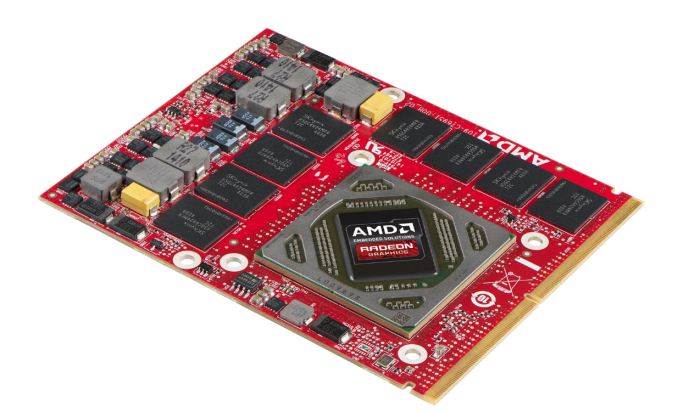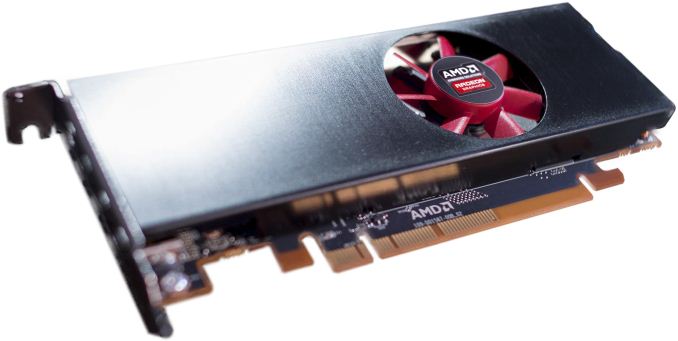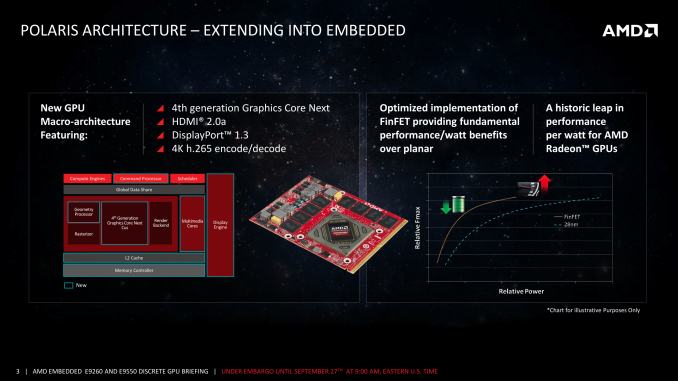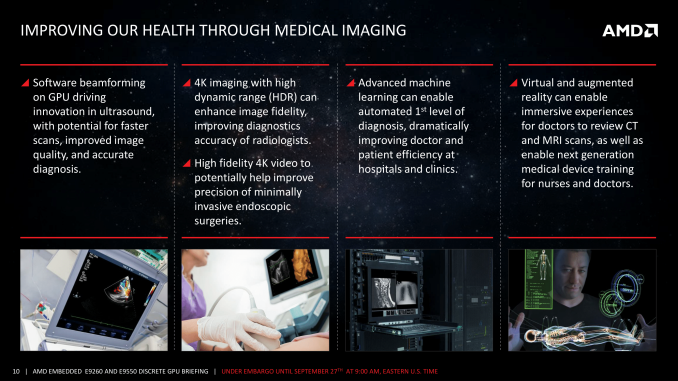AMD Announces Embedded Radeon E9260 & E9550 - Polaris for Embedded Markets
by Ryan Smith on September 27, 2016 9:00 AM EST
While it’s AMD’s consumer products that get the most fanfare with new GPU launches – and rightfully so – AMD and their Radeon brand also have a solid (if quiet) business in the discrete embedded market. Here, system designers utilize discrete video cards for commercial, all-in one products. And while the technology is much the same as on the consumer side, the use cases differ, as do the support requirements. For that reason, AMD offers a separate lineup of products just for this market under the Radeon Embedded moniker.
Now that we’ve seen AMD’s new Polaris architecture launch in the consumer world, AMD is taking the next step by refreshing the Radeon Embedded product lineup to use these new parts. To that end, this morning AMD is announcing two new Radeon Embedded video cards: the E9260 and the E9550. Based on the Polaris 11 and Polaris 10 GPUs respectively, these parts are updating the “high performance” and “ultra-high performance” segments of AMD’s embedded offerings.
| AMD Embedded Radeon Discrete Video Cards | ||||||
| Radeon E9550 | Radeon E9260 | Radeon E8950 | Radeon E8870 | |||
| Stream Processors | 2304 | 896 | 2048 | 768 | ||
| GPU Base Clock | 1.12GHz | ? | 750MHz | 1000MHz | ||
| GPU Boost Clock | ~1.26GHz | ~1.4GHz | N/A | N/A | ||
| Memory Clock | 7Gbps GDDR5 | 7Gbps GDDR5? | 6Gbps GDDR5 | 6Gbps GDDR5 | ||
| Memory Bus Width | 256-bit | 128-bit | 256-bit | 128-bit | ||
| VRAM | 8GB | 4GB | 8GB | 4GB | ||
| Displays | 6 | 5 | 6 | 6 | ||
| TDP | Up To 95W | Up To 50W | 95W | 75W | ||
| GPU | Polaris 10 | Polaris 11 | Tonga | Bonaire | ||
| Architecture | GCN 4 | GCN 4 | GCN 1.2 | GCN 1.1 | ||
| Form Factor | MXM | MXM & PCIe | MXM | MXM & PCIe | ||
We’ll start things off with the Embedded Radeon E9550, which is the new top-performance card in AMD’s embedded lineup. Based on AMD’s Polaris 10 GPU, this is essentially an embedded version of the consumer Radeon RX 480, offering the same number of SPs at roughly the same clockspeed. This part supersedes the last-generation E8950, which is based on AMD’s Tonga GPU, and is rated to offer around 93% better performance, thanks to the slightly wider GPU and generous clockspeed bump.
The E9550 is offered in a single design, an MXM Type-B card that’s rated for 95W. These embedded-class MXM cards are typically based on AMD’s mobile consumer designs, and while I don’t have proper photos for comparison – AMD’s supplied photos are stock photos of older products – I’m sure it’s the same story here. Otherwise, the card is outfitted with 8GB of GDDR5, like the E8950 before it, and is capable of driving up to 6 displays. Finally, AMD will be offering the card for sale for 3 years, which again is par for the course here for AMD.
Following up behind the E9550 is the E9260, the next step down in the refreshed Embedded Radeon lineup. This card is based on AMD’s Polaris 11 GPU, and is similar to the consumer Radeon RX 460, meaning it’s not quite a fully enabled GPU. Within AMD’s lineup it replaces the E8870, offering 2.5 TFLOPS of single precision floating point performance to the former’s 1.5 TFLOPS. AMD doesn’t list official clockspeeds for this card, but based on the throughput rating this puts its boost clock at around 1.4GHz. The card is paired with 4GB of GDDR5 on a 128-bit bus.
Meanwhile on the power front, the E9260 is being rated for up to 50W. Notably, this is down from the 75W designation of its predecessor, as the underlying Polaris 11 GPU aims for lower power consumption. And unlike its more powerful sibling, the E9260 is being offered in two form factors: an MXM Type-A card, and a half height half length (HHHL) PCIe card. Both cards have identical performance specifications, differing only in their form factor and display options. Both cards can support up to 5 displays, though the PCIe card only has 4 physical outputs (so you’d technically need an MST hub for the 5th). Finally, both versions of the card will be offered by AMD for 5 years, which at this point would mean through 2021.
Moving on, besides the immediate performance benefits of Polaris, AMD is also looking to leverage Polaris’s updated display controller and multimedia capabilities for the embedded market. Of particular note here is support for full H.265 video encoding and decoding, something the previous generation products lacked. And display connectivity is greatly improved too, with both HDMI 2.0 support and DisplayPort 1.3/1.4 support.
The immediate market for these cards will be the same general markets that previous generation products have been pitched at, including digital signage, casino gaming, and medical, all of whom make use of GPUs in various degrees and need parts to be available for a defined period of time. Across all of these markets AMD is especially playing up the 4K and HDR capabilities of the new cards, along of course with overall improved performance.
At the same time however, AMD’s embedded group is also looking towards the future, trying to encourage customers to make better use of their GPUs for compute tasks, a market AMD considers to be in its infancy. This includes automated image analysis/diagnosis, machine learning inferencing to allow a casino machine or digital sign to react to a customer, and GPU beamforming for medical. And of course, AMD always has an eye on VR and AR, though for the embedded market in particular that’s going to be more off the beaten path.
Wrapping things up, AMD tells us that the new Embedded Radeon cards will be shipping in the next quarter. The E9260 will be shipping in production in the next couple of weeks, while the E9550 will be coming towards the end of Q4.




















16 Comments
View All Comments
psychobriggsy - Tuesday, September 27, 2016 - link
So that E9550 is pretty much exactly the same specification as the 150W RX 480 (except the memory is a bit slower), except it's rated for 95W. Slightly slower memory isn't going to explain the difference. And we all know that the 480 draws slightly over 150W in real world use...Ditto the E9260 - 50W instead of 75W, and higher turbo (2.5 TFLOPS, not 2.2).
What's going on here? A new power-efficient stepping of Polaris? Or embedded cards that never go above their base clocks despite the advertised boost?
Ryan Smith - Tuesday, September 27, 2016 - link
Keeping in mind that these are derived from the mobile parts, which are binned to begin with, it's likely that there's more aggressive throttling.medi03 - Wednesday, September 28, 2016 - link
What about clock?Considering you can downclock/volt Fury to >100w levels...
BrokenCrayons - Tuesday, September 27, 2016 - link
Hmm the E9260 PCIe card looks compelling as a possible replacement for a half height GT 730. It'd probably be a pain to get your hands on one through retail channels though and there's probably a hefty markup over the RX 460.JoeyJoJo123 - Tuesday, September 27, 2016 - link
An "RX480 MXM" card inside a small NUC enclosure would be pretty awesome and should be relatively affordable, I think.Zotac did make the Zotac Zbox EN970 which used a GTX 980 MXM card, but the custom watercooling solution led to a high end-cost for the consumer, increased size and complexity, and most importantly, led to the high cost of the final unit...
I think NUCs are well priced for what they are. If they could get an MXM module slot for a cheaper discrete graphics from an RX480, and the GPU and CPU were both air cooled, we'd have a small, portable PC-console, capable of doing anything at 1080p, at about $1000 or less, which is exactly what a top-of-the-line Steam Machine needs to be.
FMinus - Tuesday, September 27, 2016 - link
Well, low-end NUCs are well priced, anything in the higher range is overpriced. And those with dedicated GPUs aren't that much smaller as well though out mini-ITX case with regular components.That being said, I'd buy a double stack sized Intel Skull Canyon NUC with a dedicated GPU in an instant.
Nevod - Tuesday, October 4, 2016 - link
One last thing to wish then would be low noise. Perhaps some server-like arrangement with a crossflow fan pulling air through whole unit with heatsinks both right on CPU and GPU and a large common heatsink near the fan, running along whole chassis.BrokenCrayons - Tuesday, September 27, 2016 - link
I'm just thinking out loud, but these MXM graphics cards could be used in laptops that have older MXM cards as long as the cooling system could handle the replacement. After all, NUCs are nice, but they're still chained to a monitor, keyboard, and mouse which might rule out using them in certain situations.I could see plucking out an older/hotter MXM GPU and replacing it with something that has a lower TDP (the 50W E9260). Even if its not a performance-oriented upgrade, using a laptop cooling system designed for a hotter card on a more modern and cooler one seems like it might be worth exploring.
IAEInferno - Tuesday, September 27, 2016 - link
Okay can someone tell me if these are new versions of the rx 480 and rx 470 line up but with lower power consumption or is it something else? I'm all new to this and I'm confused.JoeyJoJo123 - Tuesday, September 27, 2016 - link
These appear to be MXM and/or low-profile PCI-e versions of Polaris 10 (RX480) and Polaris 11 (RX470/RX460) GPUs. Polaris10 is only available in MXM form factor, Polaris11 is available in both low-profile PCI-e and MXM form factor.They're most likely binned and aggressively throttle down to keep within the comparatively very limited power constraints, so it's very likely that they perform worse than the full PCI-e card equivalents for Polaris10 (RX480) and Polaris11 (RX470/RX460).
I think of them as small form-factor and heavily underclocked RX480 and RX470 equivalents.